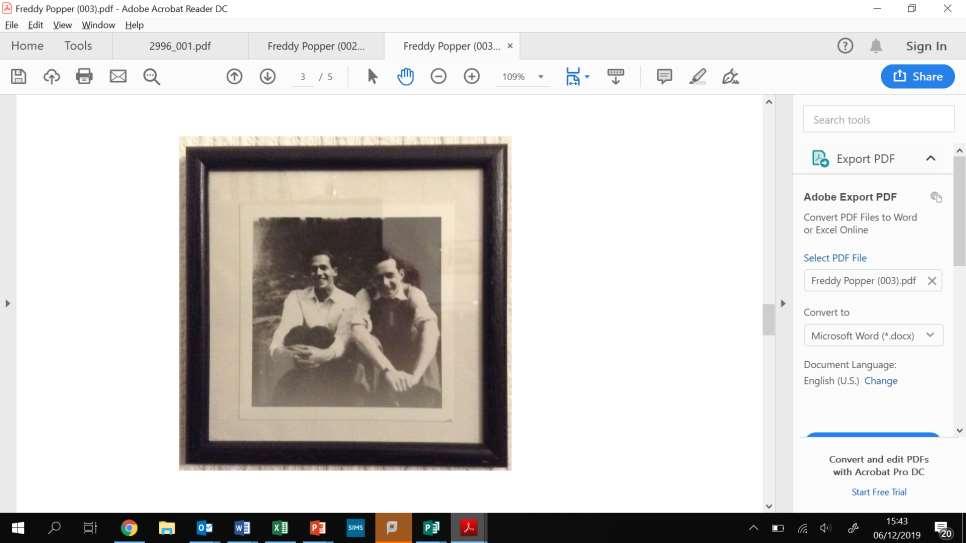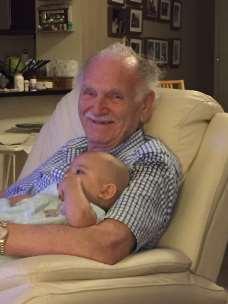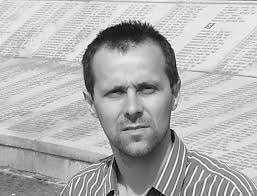
10 minute read
the Holocaust
8 The boys of Lebanon Park: George & Freddy
George Ruf lived in an apartment with his family on Bahnhofstrasse in Herne,
Germany. He had two brothers and a sister. His parents worked in a furniture shop where he would go after school to

The synagogue in Herne, still smouldering after being set alight by Nazis in
1938 Photo: Ralf Piorr
get a snack. He longed to go to the local swimming pool but because he was Jewish he wasn’t allowed to. Nevertheless, he had a very happy life until Kristallnacht, the night of broken glass, which was a violent riot, against Jews carried out by SA paramilitary forces and civilians throughout Nazi Germany on 10th November 1938. The windows in George’s parent’s furniture shop had been smashed. Pictures show the aftermath of Kristallnacht in Herne, just over seventy years ago this month. After that day, George’s family was forced to move from their home and went to live with Mr. Ganz, the president of their Jewish community in Herne. Five days later his father was taken to a concentration camp. On April 19th 1939 his mother and siblings took him to Dortmund station to go on a train to Holland, he was allowed to bring a suitcase with just a few clothes. It was the last time that George ever saw his mother. Eventually George ended up living in 52 Lebanon Park in Twickenham and when to school at St. Mary’s there. Soon after arriving he was forced to change his name to George as his real name Gunter, sounded ‘too German’. Eventually ten boys were brought to this house. He enjoyed life there, always expecting his family to join him there soon. He stayed in a room with two other boys and was looked after by Matron Kroner, which was the first time he had porridge and tea with milk. He left St. Mary’s to go to Orleans Park secondary school next door which he left when he was 14. After leaving the house at Lebanon Park George had a very interesting life. When he was 18 he rode a motorbike all through Europe and back to Herne where he met some of his old neighbours. He then joined the army and served in Hong Kong and Singapore before moving to Ecuador to manage a factory and then, finally, settling down in the USA. George eventually found out that after he left Germany his mother and sister were taken to Stutthof and his brothers to Bergen- Belsen concentration camps. His mother died on the death march in Poland in 1945. George’s father managed to escape, fighting for the British army against the Nazis in Africa before reaching England and finding George in 1946. His sister and brothers went to Australia and lived there until they died. George visited them in 1986 for the first

George Ruf today with one of his grandchildren in the USA Photo: George Ruf time, after 47 years. Last year George and his wife took their youngest daughter to see the house at Lebanon Park.
Freddy Popper was born in June 1928
in Vienna. He was born into a middleclass family that had a rich musical herit-
Freddy Popper, left , with Emil Haber, another of the boys who lived in Leba-
non Park Photo: Michael Popper
age. Freddy and his mother escaped from Vienna in 1939 and made their way to London where Freddy lived at the hostel in Lebanon Park. When Freddy left the house in December 1944 he found work as a tailor, becoming a highly -skilled pattern cutter. After travels around the country for work he settled back in Richmond Borough, living in St Margarets from the early 1990s until he passed away.
The boys who lived in Lebanon Park— do you remember them?
The young people researching the boys at Lebanon Park would like to hear from any local residents who remember those who lived there along with George and Freddy. Please do get in touch with Mr Lawrence at Hampton School if you remember: Fred Pauker, Emil Haber Gerald & Harold Ohrbach
Ralph Metzger Frank Reichmann
Kurt Kristeller
9 Cambodian survivor visited our school
A survivor of the Cambodian genocide kindly took the time to visit our school
and talk about experiences reports Lilu from Turing House School. The Cambodian genocide took place from 1975 to 1979, after the Khmer Rouge seized power of Cambodia’s capital Phnom Penh where Sokphal lived at the time. His family and many others were asked to leave the city in April 1975 after ’13-14 year olds in black uniform’ knocked on their door, at 6am in the morning. One pointed a gun at Sokphal and threatened to shoot if they didn’t leave immediately. Everyone had to leave even the elderly or disabled or else they became another victim in the genocide. He and his family left to go to the countryside with their car, not taking anything with them. The roads were packed as millions of people were chased out of their homes and hurried to become agricultural slaves. Those who didn’t die initially had to leave to work in the countryside as farmers, in fields now known as the killing fields. Sokphal worked hard every day under the hot sun in the killing fields until the Vietnamese invaded Cambodia in 1979. The killing was brutal and anyone who was educated (lawyers, teachers, doctors), disobeyed their orders or tried to steal food was executed. Meals were incredibly undersized, with a small tub of rice for an entire family. This meant, Sokphal only ate a couple of spoonful of rice a day which he had to combine with plants or grass. Some chose to add worms or bugs to their diet however they often carried dangerous diseases and therefore people died as no medicine was available to them. At the time, Sokphal was a student but fortunately lost his ID so he could convince the soldiers he was an uneducated boy selling newspapers and had no idea how to read or write. After a couple of months of backbreaking work, Sokphal and his family were told they’d get reunited with his father, who was taken away to be ‘reeducated’, but they were taken deep inside a jungle and abandoned without anything helping them to survive. His grandmother, whom he was close with, soon fell ill and without any medicine she passed away in his arms. Soon after, Sokphal was taken away to continue working in a labour camp, separated from his family. Two days after he left, he heard the petrifying news that his little brother, who was only six years old, had died of malaria. The Khmer Rouge ordered him to train as a soldier but he vowed never to execute anyone. When the Vietnamese invaded on December 25th of 1979, Sokphal was captured as the Vietnamese army believed he was a soldier by choice. He was ruthlessly tortured for

information through methods such as being held in a brick oven, to be burned alive. At last, a fellow prisoner arranged for both their releases and he was reunited with his family soon after. The family made their way to a refugee camp in Thailand in hopes to start a better life in another country. The way was dangerous as they could be recaptured anytime but by good luck they managed to escape. For seven years Sokphal and his family lived in refugee camps but ultimately they made contact with a cousin living in England who sponsored them through the Red Cross. In 1987, Sokphal and his family could, despite everything they’ve been through, start a new, safe, peaceful life away from the horrors of the genocide. The number of people executed isn’t clear but estimates place it between one and two million murders with a few survivors able to share such a traumatic experience with Sokphal being one of those few. I am incredibly grateful to have had the opportunity to listen to his story knowing the impact it had on him. I recommend for everyone to take an offer such as this if possible as you can gain a tremendous amount of knowledge on history from all around the world and it can help to prevent events such as this genocide from being repeated in the future. Thank you so much Sokphal for sharing your story.
Photo: Turing House School
Tragedy of Darfur through childrens’ eyes
All victims of genocides like the one in Darfur deserve commemoration. Nevertheless, somehow it is the suffering of children that strikes home the most. That is why the drawings of child victims of the genocide in Darfur, collected by charity Waging Peace UK, are so tragic. They show horrific attacks on the childrens’ villages by Janjaweed militia & government aircraft. I hope that there may be an exhibition of them soon in our local area so that more people can learn about what happened to the children of Darfur.
10 After visiting Auschwitz we must speak out

Photo: Louis Fell
Matt and Paul report on the impact of
their trip to Auschwitz-Birkenau After a three hour flight from Gatwick to Krakow and a coach journey we came to the town of Oswiecim in Poland. The Nazis called it Auschwitz. It was freezing and snow covered the ground. The weather provided a suitable backdrop for what would prove to be a challenging day. A tour of the camp, where we furthered our knowledge of the appalling way in which Jews and other persecuted minorities were treated. This was all in build-up though for the Jewish prayers led by a Rabbi. This was a very powerful and moving service, and there was not a better way for us to pay our respects to those who had lost their lives, and those who still suffer from anti-Semitism today. This moment will stay with us for the rest of our lives.
Having retuned to London after a draining day, both physically and emotionally, we knew that our work was not finished.
During the Lessons from Auschwitz course, on top of the moving experience of visiting Auschwitz-Birkenau, we were fortunate to meet Holocaust survivor Eva Campbell, and hear her inspirational words. Eva powerfully conveyed the message that each of the 6 million victims of the Holocaust had an individual life, full of opportunities, that was brutally cut short. However, for me her most poignant and moving words were ‘there is no such thing as an innocent bystander.’

Moreover, in the final part of the course we, took inspiration from Eva on the importance of individualising the Holocaust. We focused our Next Step project on the lives of two victims. We created podcasts, to educate students in the lower years of our school, describing the lives of Gezela Band and Bela Guttmann before the Holocaust and their traumatic experience during it. Although we have finished the formal course as ambassadors of the Holocaust Educational Trust, we have a duty to speak out against injustices and acts of persecution for the rest of our lives.
Paul and Matt were inspired by their visit to Auschwitz to make a podcast about Bela Guttman and Gezela Band

Meeting Nedzad
Nedzad Avdic was 17 years old when he was taken for execution. As a young Muslim man in the Bosnian town of Srebrenica he was a target for Bosnian Serb soldiers in 1995. We were lucky enough to ask Nedzad a few questions.
As a boy Nedzad witnessed how hate, left unchecked, can develop with truly awful consequences. He told us that “Students should learn about all these horrific crimes and see how seemingly
Nedzad Avdic survived the genocide in Srebrenica Photo: Holocaust Memorial Day Trust
trivial things can lead to terrible outcomes. How people were killed, burned, buried alive just because of a different name, skin colour or the God they pray to. In Bosnia, the people were so similar that one could not know who this or that man was and what his religion was. Nevertheless , there was a bloody war that ended with the genocide.” Looking ahead Nedzad thinks that “by talking, witnessing and educating younger generations we can change something in the future”.




